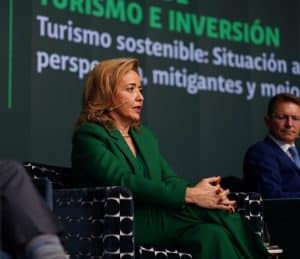Cristina Leon Vera | 06/02/2024
The BDH bank, a leading institution in the Dominican Republic and a partner of MAPFRE in this country, has held its first forum on sustainable tourism which Paola Serrano, CRMO for the LATAM and International markets attended on behalf of MAPFRE Global Risks.
For the tenth consecutive year, the BDH Bank of the Dominican Republic is attending FITUR to promote tourism on their island. To get things rolling, on the afternoon of January 23, they held their first BHD Tourism and Investment Forum. The event kicked off with a welcome by Steven Puig, Chairman of the financial institution, and David Collado, Minister of Tourism of the Dominican Republic.
The forum was divided into two parts. The first half consisted of contextualizing the evolution and perspectives of the Dominican Republic’s economy, with Bernardo Fuentes, Vice President of Economic Studies at the BHD Bank. Next, Jackeline Mora, Technical Vice Minister of Tourism, described how tourism investment in the country is being promoted by the government.
The second half consisted of a panel entitled Sustainable Tourism: Current Situation, Perspective, Mitigating Circumstances and Best Practices. This roundtable was headlined by Paola Serrano, MAPFRE Global Risks CRMO; Haydee Kuret de Rainieri, member of the Puntacana Group Council, David Llibre; Chairman of Asonahores and Felipe Buhigas, Director of Solunion.
The moderator, Luis Molina, Senior Vice President of Corporate and Business Banking, jumpstarted a roundtable discussion addressing the risks facing the tourism sector in terms of sustainability, trends, innovation and changes needed to ensure a more sustainable future in tourism.
Paola Serrano explained the commitment undertaken to be sustainable in all its lines of business by the MAPFRE Group, and specifically MAPFRE Global Risks. In one of her interventions, she differentiated two types of risks facing the tourism sector. On the one hand, the risks derived from scarce tourist planning and, on the other, climate change.
“The degradation of the environment, the loss of cultural heritage, social exclusion and economic dependence can erode the ability of the destination to maintain sustainable tourism in the long-term. This can lead to the collapse of the tourism sector, negatively impacting the entire local community.” And she continued her exhibition by mentioning the weather events that an area like Central America faces from time to time. “In the Caribbean, hurricane season coincides with a period of high tourist traffic, so the sector suffers directly from the damage caused by climate change. It is precisely under these circumstances that the role of insurance is made evident as a fundamental element for sustainability, facilitating a rapid recovery of normality.”
 With regard to future trends, Paola Serrano was “optimistic,” because “in the business field there is a paradigm shift, understanding sustainability as a competitive advantage, and it is the demands of the customers themselves that will condition and drive sustainability. In short, responsible and sustainable tourism.”
With regard to future trends, Paola Serrano was “optimistic,” because “in the business field there is a paradigm shift, understanding sustainability as a competitive advantage, and it is the demands of the customers themselves that will condition and drive sustainability. In short, responsible and sustainable tourism.”
In one of her latest interventions, Paola Serrano, who has 30 years at MAPFRE under her belt, highlighted the value “of being the insurers of the main Spanish hotel chains in more than 20 countries; companies, the vast majority of which, are greatly committed to sustainability. What’s more, all of them meet our ESG criteria for customers and providers.”
This first forum was attended by around 300 people, including Juan Bolívar Díaz, ambassador of the Dominican Republic in Spain; government, diplomatic and consular officials of the Dominican Republic; local officials, Dominican and Spanish entrepreneurs and executives from BHD, among other figures in the tourism industry.
From January 24 to January 28, FITUR opened its doors to the world to host tourism professionals, as well as responsive markets and issuers in Latin America. With expectations of more than 86,000 people, more than 136,000 professionals and 8,500 showcasing companies, FITUR takes the crown once more as “the global meeting point” for the industry.





